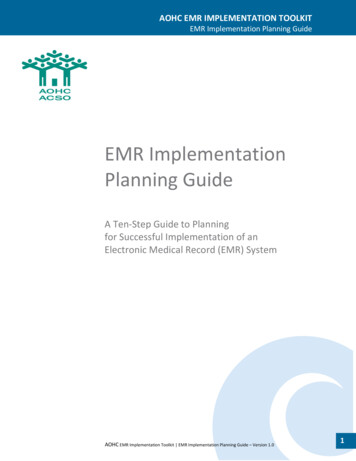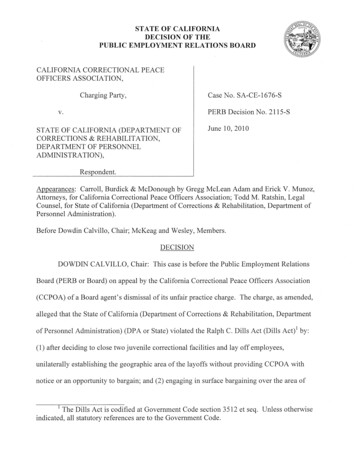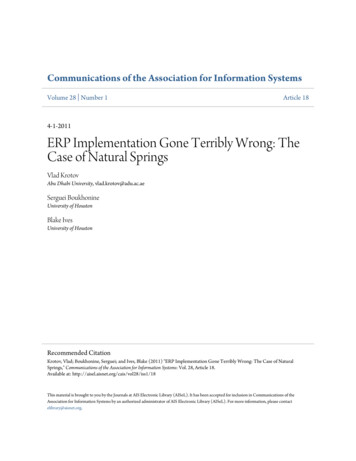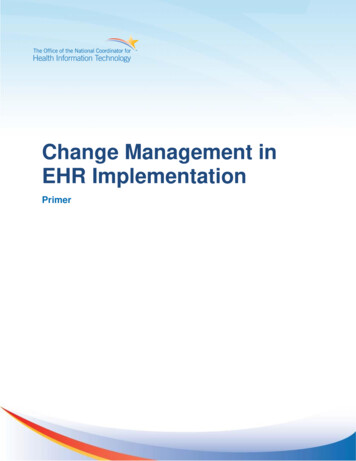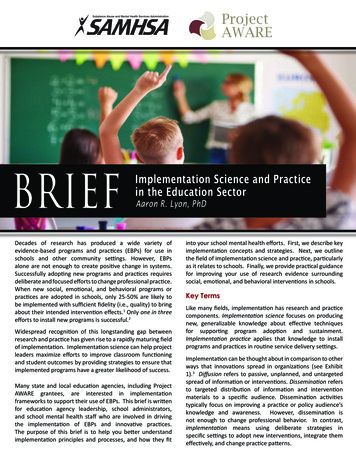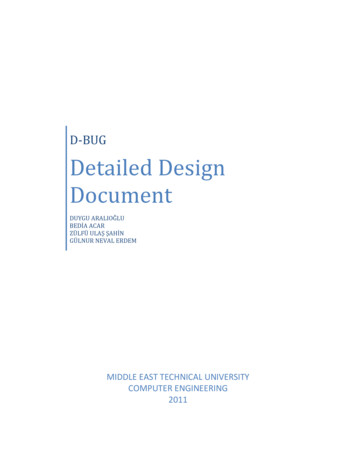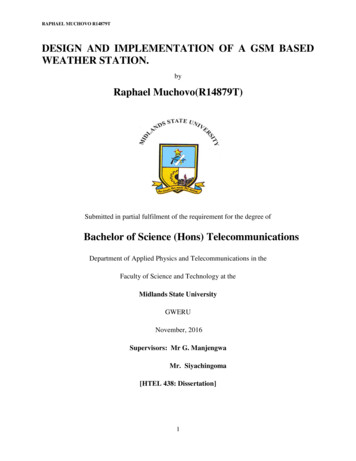
Transcription
RAPHAEL MUCHOVO R14879TDESIGN AND IMPLEMENTATION OF A GSM BASEDWEATHER STATION.byRaphael Muchovo(R14879T)Submitted in partial fulfilment of the requirement for the degree ofBachelor of Science (Hons) TelecommunicationsDepartment of Applied Physics and Telecommunications in theFaculty of Science and Technology at theMidlands State UniversityGWERUNovember, 2016Supervisors: Mr G. ManjengwaMr. Siyachingoma[HTEL 438: Dissertation]1
RAPHAEL MUCHOVO R14879TABSTRACTA wireless remote weather station is an ideal solution for knowing the weather conditions at aspecific remote location. Weather forecasts are informative, but they are only a forecast. With aRemote Weather Station, one would always know the exact weather conditions from where everthe Remote Weather Station is located. This project seeks to devise a simple low cost microcontroller based remote weather station that measure weather conditions using sensors tomeasure temperature, humidity, atmospheric pressure, rainfall received, and light intensity,displays it on LCD and forwards it to a remote user by SMS. This project is developed by usingArduino uno, SIM900 GPRS/GSM shield, LCD display, temperature, humidity, atmosphericpressure and light intensity sensors. The advantage of using GSM based technology is that GSMbased communication network is widespread in Zimbabwe and have almost reached every cornerof the country. GSM technology also provides users with high quality signal and channels,giving them access to high quality digital communication at very affordable rates. Thismicrocontroller based weather station can be useful to anyone who wishes to monitor theweather conditions of a location without being physically there.2
RAPHAEL MUCHOVO R14879TDECLARATIONI, Raphael Muchovo, hereby declare that I am the sole author of this thesis. I authorize theMidlands State University to lend this thesis to other institutions or individuals for the purposeof scholarly research.Signature Date3
RAPHAEL MUCHOVO R14879TAPPROVALThis dissertation/thesis entitled DESIGN AND IMPLEMENTATION OF A GSM BASEDWEATHER STATION by RAPHAEL MUCHOVO meets the regulations governing theaward of the degree of BSC TELECOMMUNICATIONS HONOURS of the Midlands StateUniversity, and is approved for its contribution to knowledge and literal presentation.Supervisor Supervisor Mr G. ManjengwaMr SiyachingomaDate Date 4
RAPHAEL MUCHOVO R14879TACKNOWLEDGEMENTSI would like to thank the almighty God for giving me the strength and endurance to carry out thisproject. Special thanks go to my supervisors (Mr. G. Manjengwa and Mr. Siyachingoma) fortheir guidance and support. I would also like to thank all the staff members of the department forhelping me during my studies. Lastly Iam indebted to the love and support from my lovely wifeLonah Zindoga. She was a pillar of strength when the going gets tough.5
RAPHAEL MUCHOVO R14879TLIST OF FIGURESFig 1: Professional -----------------------------9Fig 2.1: Liquid crystal ---------------------------11Fig 2.2: Arduino micro-controller -------------12Fig 2.3: Arduino sim900 gprs/gsm -------------13Fig 2.4:DHT11 humidity and temperature ---14Fig 2.5: BMP180 digital barometric pressure 14Fig 2.6: raindrop detection ---------------------15Fig 2.7 : BH1750 digital light -----------------16Fig 3.1: system block --------------------------22Fig 3.2: DHT11 pin ----------------------------23Fig 3.3: BMEP280 connection with ----------24Figure 3.4: rain sensor module to arduino --25Figure 3.5: Gsm shield to arduino -----------26Fig 3.6: BH1750 connection with ------------26Fig 3.7: connections for -----------------------27Fig 3.8: system flowchart ---------------------28Figure 3.9: System schematic ----------------29Figure 4.1: developed --------------------------31Figure 4.2: temperature and humidity measurement e 4.3: BMEP280 pressure, altitude and temperature measurements-------------------33Figure 4.4: light intensity ------------------34Figure 4.4: overall system -----------------35Figure 4.5: received text message on user’s 6Fig 4.6: raining -------------------------------366
RAPHAEL MUCHOVO R14879TLIST OF TABLESTable 1: BH1750 digital sensor7
RAPHAEL MUCHOVO R14879TABBREVIATIONSGSM – Global system for mobile communicationSMS – Short message serviceAWS – automatic wireless systemGPRS – general packet radio systemIDE – intergrated development envirRTC – real time clock8
RAPHAEL MUCHOVO R14879TContentsCHAPTER 1: INTRODUCTION . 111.1 BACKGROUND TO THE STUDY . 111.2 PROBLEM STATEMENT . 121.3 AIM . 131.4 OBJECTIVES . 131.5 JUSTIFICATION . 131.6 SCOPE . 131.7 MOTIVATION . 14REFERENCE . 15CHAPTER 2: THEORATICAL ASPECTS . 162.1 INTRODUCTION . 162.2 LITERATURE REVIEW . 162.2.1 WEATHER MONITORING BY USING SIMPLE INSTRUMENTS. 162.2.2 AUTOMATIC WEATHER STATION (AWS). 172.2.3 DIGITAL WEATHER STATION . 182.2.4 MONITORING SYSTEM OF A WEATHER STATION VIA IP . 182.3 HARDWARE COMPONENTS . 182.3.1 LIQUID CRYSTAL DISPLAY (LCD) . 192.3.2 ARDUINO UNO. 192.3.3 ARDUINO SIM900 GPRS/GSM SHIELD . 202.3.4 DHT11 TEMPERATURE AND HUMIDITY SENSOR . 212.3.5 BMEP280 PRESSURE SENSOR . 222.3.7 RAINDROP MODULE SENSOR . 232.3.7.1 SPECIFICATIONS . 232.3.8 BH1750 DIGITAL LIGHT INTENSITY SENSOR . 242.4 SOFTWARE . 252.4.1 ARDUINO SOFTWARE . 252.4.2 ARDUINO SKETCH. 252.4.3 PROTEUS PCB DESIGN AND SIMULATION SOFTWARE . 262.4.4 MICRO-CONTROLLER SIMULATION . 26REFERENCES . 27CHAPTER 3: METHODOLOGY . 299
RAPHAEL MUCHOVO R14879T3.1 INTRODUCTION . 293.2 SYSTEM DESIGN . 293.3 BLOCK DIAGRAM OF THE SYSTEM . 303.4 HARDWARE CONNECTIONS . 313.4.1 ARDUINO UNO. 313.4.2 TEMPERATURE AND HUMIDITY SENSOR . 313.4.3 ATMOSPHERIC PRESSURE SENSOR . 323.4.4 RAIN DETECTION SENSOR . 323.4.5 ARDUINO GSM SHIELD . 333.4.6 LIGHT INTENSITY SENSOR . 343.4.7 LIQUID CRYSTAL DISPLAY (LCD) . 353.4.8 SOFTWARE . 353.4.9 FLOWCHART FOR SYSTEM SOFTWARE . 363.5 INTEGRATED SYSTEM. 37REFERENCES . 38CHAPTER 4: RESULTS AND ANALYSIS . 394.1 INTRODUCTION . 394.2 RESULTS . 404.2.1 HUMIDITY AND TEMPERATURE MEASUREMENTS . 404.2.2 PRESSURE MEASUREMENT . 414.2.3 LIGHT INTENSITY MEASUREMENT . 414.2.4 OVERAL WEATHER STATION RESULTS. 424.2.5 ANALYSIS OF RESULTS . 454.2.6 LIMITATIONS . 45CHAPTER 5: CONCLUSION AND RECOMMENDATIONS . 46CONCLUSION . 46RECOMMENTATIONS . 46APPENDIX: WEATHER STATION CODE USING ARDUINO SOFTWARE . 4710
RAPHAEL MUCHOVO R14879TCHAPTER 1: INTRODUCTION1.1 BACKGROUND TO THE STUDYWeather monitoring is of great importance because if affects many human activities. InZimbabwe weather monitoring and forecasting is very important to farmers so that they knowwhen to plant, weed or harvest their crops. The agriculture sector is of key importance inbankrolling the economy of Zimbabwe, since it contributes 15 to 19 percent of the country’sGross Domestic Product. This shows that the agriculture sector contributes a large income andplays a vital role in the economy of the country. In order to produce quality crops farmers rely oncorrect weather prediction and monitoring. Failure to correctly predict weather conditions leadsto reduced expected yield and hunger.The Zimbabwe metrological services provide weather forecasting information throughout thecountry. The weather monitoring and forecasting system in our country is outdated compared todeveloped countries. Weather forecasting information provided by the Zimbabwe metrologicalservices is recorded by weather stations located in the nearby cities or towns and not necessarilythe conditions at a farm located hundreds of kilometers away. The use of a remote weatherstation can help farmers to monitor the weather conditions at their farms, hence the need todesign a low cost, automated and portable weather station. Weather monitoring allows farmers tokeep a track record of weather parameters including temperature, humidity, atmosphericpressure, light intensity rainfall, wind speed and wind direction.The study of day-to-day weather requires a connection of a couple of instruments together toform a weather station. A weather station is an observation post where weather conditions andmeteorological data are observed and recorded. Weather stations provide weather forecastinginformation to aviation, agriculture, construction, or shipping [1]. Weather forecasting andmonitoring is the application of science in predicting the atmospheric conditions of any givenplace. Weather forecasting is done through collection of quantitative and qualitative data of theprevailing state of the atmosphere at a given place. Weather prediction and forecasting is basedon understanding various scientific atmospheric processes in predicting how the weather willchange [1].11
RAPHAEL MUCHOVO R14879TModern weather stations are automated remote weather stations which are updated versions ofthe common weather stations which have been in existence for centuries. The automated remoteweather station uses a sensor network to measure different atmospheric parameters. A sensornetwork is a network of microcontroller integrated with spatially distributed smart devices andsensors. A sensor is used for monitoring a real world physical condition or variable such asbarometric pressure, wind speed, humidity, wind speed, temperature, wind direction, andprecipitation amount [2]. An automated remote weather station is used minimise human effort,and to enable measurement of weather parameters from remote areas that are not easilyaccessible to human beings. The disadvantage of the manual weather station is that it requireshuman effort, skills, power and energy to get its results.This project will design and implement a GSM based remote weather station using an embeddedsystem to monitor the weather parameters at a remote location through sensors. GSM technologyis widespread cheapest wireless technology in Zimbabwe that is convenient to use since almosteveryone owns a mobile phone. To check the status of the weather, the user will send a ShortMessage Service (SMS) text to the remote weather station and get a reply about the status of theweather conditions where the remote weather station is located. The wireless remote weatherstation will be designed using basic and cheap components such as GPRS/GSM shield.1.2 PROBLEM STATEMENTTraditional weather stations lack self-sustainability, autonomous logging capabilities and theability to transmit data wirelessly. Furthermore, professional weather stations are too expensivefor the average consumer and they have got a limited range of transmission. Although it is notpossible to monitor the weather parameters of all the places as some places are not easilyaccessible, the advancement of science and technology can provide us a way to get informationof such places by the use of wireless devices. With the use of GSM based remote weatherstation, we can monitor the weather conditions of desired remote places. The data from theremote location is made available to the user by sending an SMS text containing values ofmeasured weather conditions, using the GSM network. At any time the user is able to send anSMS to the remote weather station and get a reply about the status of temperature, humidity and12
RAPHAEL MUCHOVO R14879Trainfall. The proposed system will use wireless communication technology to provide real timeaccess to weather conditions at a remote place.1.3 AIMThe main aim of this research is to design and implement a wireless remote weather station. Theweather station will measure weather conditions using various sensors that measure temperature,light intensity, relative humidity and atmospheric pressure. A central micro-controller will beused to collect all the data from the sensors and send it to a remote user using a GSM network.1.4 OBJECTIVESThe objectives of this research are: To design a micro-controller based system that automatically measures weatherparameters using sensors. To develop a cheap, portable remote weather station.1.5 JUSTIFICATION The wireless remote weather station will be beneficial to agriculture, industry, andmining and tourism sectors of the economy. The system will help these sectors in weathermonitoring and forecasting, thus enabling proper planning on various activities to becarried out. The system will allow monitoring of weather conditions of any desired remote place fromanywhere in the world using the widespread GSM network. The design of a cost effective , portable , easy to maintain and affordable weatherstation will help to give warning of catastrophic weather conditions such as elnino thatimpact weather patterns causing drought. Zimbabwe is often a victim of such calamities,causing hunger, starvation and untold suffering This project can be used by University students studying mateorology to carry outresearch on weather.1.6 SCOPE The immediate scope of this project is to monitor the weather conditions ofa remote place using GSM technology.13
RAPHAEL MUCHOVO R14879T This weather station measures five parameters, which are temperature, humidity, atmosphericpressure and light intensity. These parameters are measured and monitored through sensors.1.7 MOTIVATIONThe primary motivation behind taking up this project is the large utility of the wireless weathermonitoring in varied areas ranging from agricultural growth and development to industrialdevelopment. The weather conditions of a field can be monitored from a distant place by farmersand won’t require them to be physically present there in order to know the climatic behavior atthe location by using wireless communication. I14
RAPHAEL MUCHOVO R14879TREFERENCE[1] A Guide to the Siting, Exposure and Calibration of Automatic Weather Stations forSynoptic and Climatological Observations, By Andrew K. Overton.[2] http://www.mstarlabs.com/; Temperature Measurements using Data AcquisitionProcessors[3] Zhang Hong, Zhang Jie. Wireless sensor network technology based on coal minesafety monitoring system [J]. Microcontroller and Embedded Systems, 2009[4] “Data sheet, ICATmega328, Arduino Uno, LDR, BMP180, Zigbee”,[5] https://www.arduino.cc/en/Guide/HomePage15
RAPHAEL MUCHOVO R14879TCHAPTER 2: THEORATICAL ASPECTS2.1 INTRODUCTIONThe researcher carried out extensive literature review related to the design and implementation ofa remote weather station in order to find out previous work carried out by other researchers. Inprevious studies most of the researchers have used both wired and wireless technologies totransmit measured weather parameters to a remote user. P.Susmitha has developed a weatherforecasting and monitoring that enables monitoring of weather conditions in industries [1]. Thesystem has, a microcontroller, Gas and humidity sensors. The microcontroller acquires the datafrom sensors and sends it to a computer through the Serial port. There are many systems forremote weather stations, designed as commercial products or experimental research platformsusing various techniques. The techniques used in some of these researches were quite expensiveand were not global. However my proposal is to design and implement a remote weather stationusing open source hardware and software. The system will use modern digital sensors which aremore compact, robust and efficient. At the heart of the system will be an arduino microcontrollerthat will send the measured parameters to a GSM module which transmits the data wireless to theuser. The advantage of using GSM technology is that it is widespread in Zimbabwe. Usingwireless technology also offers the ability to measure weather data during disasters when humanbeings cannot be physically there. The hardware and software components used in the designand implementation of this project will be discussed and show that they are a suitable choice toreach the objectives set for this project.2.2 LITERATURE REVIEW2.2.1 WEATHER MONITORING BY USING SIMPLEINSTRUMENTSFor many years simple instruments and techniques have been used in order to measure weatherchanges. Basic weather measuring instruments like cup anemometer and wind vane had beenused to measure wind speed and direction. These instruments are still widely used in mostcommon weather monitoring technologies today. Barometers, thermometers, rain gauges andhygrometers, are the vital tools for weather monitoring, from which more advanced technologies16
RAPHAEL MUCHOVO R14879Tused in weather monitoring are developed [2]. However measuring weather data using thistraditional way has the disadvantage that the system requires constant intervention of the humanbeing to record the data manually. Furthermore it is difficult to monitor the weather stationremotely as it cannot be easily integrated with modern technologies.2.2.2 AUTOMATIC WEATHER STATION (AWS)Automatic weather station (AWS) is a system that enables the collection of meteorologicalobservations automatically. An AWS comprises a number of sensors, a data logger (housed in awaterproof enclosure) and a power supply. Typically, an AWS has got sensors that measurevarious weather parameters like rainfall, atmospheric temperature, wind speed, humidity,pressure, and direction [3]. The advantage of AWS over a traditional manual weather station isthat it is far less labour-intensive. Provided an AWS is regularly checked to ensure that it isfunctioning properly, it does not need to be physically attended so that results can be manuallyrecorded. Professional AWS such as the one depicted in the fig below are available online.However, the capital-intensive nature of AWS often means that it is too expensive to set up alarge number of stations. Consequently, data-hungry forecasting models, which operate bestwhen fed with a vast quantity of observations from a very dense network of AWS, cannotoperate to their full capacity. In addition professional AWS are not available on the local market.Fig 2.1: Professional AWS17
RAPHAEL MUCHOVO R14879T2.2.3 DIGITAL WEATHER STATIONThis journal proposed to build a weather station with a digital display. This weather station ispowered by a power supply. The analog signal from sensors is converted to a digital signal. Thisweather station provides reading parameters for pressure, rainfall, temperature, humidity, winddirection and wind speed and could only display one parameter from the weather station at onetime [2]. The limitations of this system are that it cannot be monitored remotely and requires thephysical presence of the human being to take readings. Moreover the system lacks autonomousdata logging capability which is crucial for future weather forecasting and prediction2.2.4 MONITORING SYSTEM OF A WEATHER STATION VIAIPFrom this journal, a monitoring system for weather station was developed. They convertedanalog signal from sensor to digital signal to be read by computer via data acquisition card usb6009 and using LabView as application software to interface the data from weather station [1].This method is limited by availability of internet connection to access the remote weather station.This system cannot be used in rural areas since internet access is limited and some areas are notcovered at all.2.3 HARDWARE COMPONENTSThe following hardware components will be required to successfully accomplish the objectivesof this project. Liquid crystal display Arduino uno Microcontroller Arduino GPRS/GSM shield Barometric pressure sensor Temperature and humidity sensor Rain detection module sensor Light Intensity sensor18
RAPHAEL MUCHOVO R14879T2.3.1 LIQUID CRYSTAL DISPLAY (LCD)A liquid-crystal display is a flat electronic display panels that use light modulationproperty of liquid crystals. Liquid crystal display does not emit light directly. The principle ofLCD depends on two sheets of polarized material with a liquid crystal solution. If an electricalcurrent is passed through, the crystals to align so that light is blocked and does not pass through[10]. Each crystal is like a shutter, which either blocks the light or allows it to pass through. LCDs has got temperature range of -10 to 60 for them to function properly and has a lifetime ofmore than 50000 hours (without direct irradiation of sunlight). Fig 1 below shows a typical 16x2display.Fig 2.2: Liquid crystal display2.3.2 ARDUINO UNOArduino is based on open-source computing platform that has got a very simple input/outputboard and implements Processing/Wiring language as a development environment. The Arduinoplatform provides an integrated development environment (IDE) which has got support for Cand C programming languages. Arduino boards may either consist of an Atmel 8-, 16- or 32bit and AVR microcontroller that facilitates programming and can be incorporation into othercircuits easily. The Arduino Uno i microcontroller board architecture is based on ATmega328AVR microcontroller. Arduino has got 14 digital input/output pins (six pins are used as PWMoutputs), six analog inputs, an ICSP header a 16 MHz ceramic resonator, a power jack, a USBconnection, and a reset button. The arduino board has got everything that is needed to supportsmicrocontroller. It can either be powered through a USB connection or through an external19
RAPHAEL MUCHOVO R14879Tpower adapter. The source of power automatically selected. The 14 digital pins can be usedeither input or output pins [5].Fig 2.3: Arduino micro-controller board2.3.3 ARDUINO SIM900 GPRS/GSM SHIELDThe SIM900 GSM/GPRS Shield uses the GSM cellular network to receive and transmit data tothe user. The SIM900 GSM/GPRS shield is a complete Quad-band GSM/GPRS module that hasgot a single powerful chip processor. The SIM900 delivers GSM/GPRS 850/900/1800/1900MHzservices for SMS, voice, Fax, Data, and has got very low power consumption.20
RAPHAEL MUCHOVO R14879TFig 2.4: Arduino sim900 gprs/gsm shield2.3.4 DHT11 TEMPERATURE AND HUMIDITY SENSORThe DHT11 sensor is used for measuring air temperature and relative humidity of theatmosphere. DHT11 Temperature & Humidity digital sensor has got three pins and ischaracterized by very low power consumption. The temperature ranges from –40 C to 123.8 C,and range for relative humidity is from 0–100%. The DHT11 Sensor has got a temperature andhumidity sensor that has got a precisely calibrated digital output signal. The DHT11 has got asuper long term stability and high reliability. The sensor uses exclusive digital-signal-acquisitiontechnique to measure temperature and humidity based on sensing technology. This sensorincorporates NTC temperature measurement component and a resistive-type humiditycomponent. The DHT11 sensor can be connected to high performance 8-bit microcontroller,giving excellent quality, fast response, and anti-interference ability and is very cost-effective.The DHT11 is a basic, low-cost digital temperature and humidity sensor. The sensor is verysimple to use, however it requires very accurate timing to acquire data. The only disadvantage ofthis sensor is that new data is only acquired after a two seconds delay.21
RAPHAEL MUCHOVO R14879TFig 2.5:DHT11 humidit
Arduino uno, SIM900 GPRS/GSM shield, LCD display, temperature, humidity, atmospheric pressure and light intensity sensors. The advantage of using GSM based technology is that GSM based communication network is widespread in Zimbabwe and have almost reached every corner of the country. GSM technology also provides users with high quality signal and channels, giving them access to high quality .
